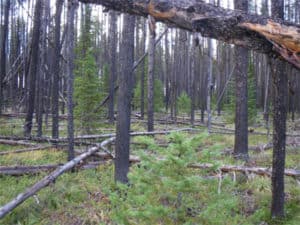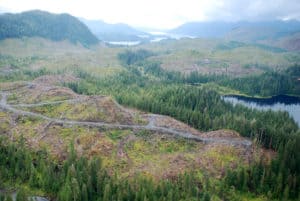Mountain goat removal (new decision)
Utah Native Plant Society v. U. S. Forest Service (10th Circuit)
The circuit affirmed the district court dismissal of an attempt to force the Manti-La Sal National Forest to remove mountain goats that the state of Utah had introduced to prevent them from harming a research natural area. It held that neither laws or regulations gave the Forest Service authority to prohibit the state action to introduce the goats on nearby state lands or to require a permit. It also held that, while the Forest Service had the authority to remove the mountain goats, it had not made a final decision on whether to do so, or to take other possible actions to protect the RNA, and therefore could not be sued. This case was discussed previously here and here.
Hells Canyon grazing (new decision)
Greater Hells Canyon Council v. Stein (D. Or.)
Magistrate Judge Patricia Sullivan released her findings on a lawsuit (previously discussed here) brought by the Greater Hells Canyon Council claiming cattle grazing on the Hells Canyon allotments were imperiling the Spalding’s catchfly, a rare wildflower found only in the inland Northwest and listed as threatened under the Endangered Species Act. In her findings, Sullivan disagreed with the plaintiff’s assertions that the Forest Service lacked sufficient baseline monitoring data for the catchfly and that the agency was required to consider an alternative that would eliminate grazing in all areas where catchfly grow. Sullivan’s findings also denied the plaintiff’s claim that the Forest Service violated the Hells Canyon National Recreation Area Act.
Target shooting (settlement)
Los Padres ForestWatch v. U.S. Forest Service
The lawsuit alleged violations by the U.S. Forest Service of the National Forest Management Act and the Endangered Species Act from unregulated target shooting in the Los Padres National Forest (discussed here). A ban on unmanaged target shooting in the forest was approved as part of the forest plan in 2005, making it consistent with the three nearby national forests, but it was never implemented. Under an agreement approved in U.S. District Court, the Forest Service will extend a temporary ban on target shooting outside of designated sites, and prepare studies and consult with federal wildlife agencies to assess and reduce the impacts of target shooting on rare and endangered plants and animals including the California condor, California red-legged frog, southern mountain buckwheat, and Kern mallow. A report also noted that target shooting has caused at least 53 wildfires in the Los Padres National Forest during the past 25 years.
Sage grouse plans (update)
Western Watersheds v. Schneider (D. Idaho)
The plaintiffs challenge 15 different Environmental Impact Statements (EISs) and their associated land use plans issued in 2015 that govern land covering ten western states. The EISs were issued as part of a National Planning Strategy by the BLM and Forest Service to update protections for sage grouse. This lawsuit was stayed for a lengthy period as the parties pursued settlement. But more recently, the BLM has issued amendments (referred to as the 2019 Amendments) to the 2015 Plans. (The Forest Service has completed a DEIS for similar amendments.) The court has granted plaintiffs’ motion to supplement their complaint to challenge the amendments as well as part of the ongoing case.
Rosemont copper mine (update)
A motion for a preliminary injunction was filed on May 15 pertaining to five lawsuits filed over the last two years against a proposed copper mine in the Santa Rita Mountains on the Coronado National Forest. A long article on what is involved and what has happened is here.
Idaho sheep experiment station (unsettlement/new case)
A previous case involving the experiment station on the Caribou-Targhee National Forest was discussed here (the settlement was discussed in a comment). In the prior settlement, the federal government agreed to prohibit grazing until a study was completed assessing the risk of domestic sheep transmitting diseases to bighorn sheep. The USDA completed an environmental analysis last summer and said last fall that it intended to resume grazing this year. A new lawsuit was filed in February to protect bighorns, grizzly bears, sage grouse and other wildlife.
Fremont-Winema grazing (new case)
The complaint filed by Concerned Friends of the Winema and four other groups marks the fourth case in about a decade alleging violations of federal statutes in the Antelope allotment. This lawsuit accuses the U.S. Forest Service of unlawfully approving a 10-year grazing permit for the allotment despite “irreparable harm” to the threatened Oregon spotted frog and wetland plants and mollusks. An injunction was dissolved earlier this year in a previous lawsuit (discussed here).
Hammond brothers grazing permit (new case)
Conservation groups filed suit challenging former Interior secretary Ryan Zinke’s order to renew grazing permits for Oregon ranchers Dwight and Steven Hammond after BLM had cancelled them in 2014 when the agency determined they didn’t qualify for a renewal based on a lack of “satisfactory record of performance” (which purportedly precipitated the standoff at the Malheur National Wildlife Refuge with the Bundy Gang). The lawsuit says that Zinke misinterpreted the effect of the presidential pardon of the Hammonds for setting a series of fires on federal lands without authorization and interfering with firefighters, and that there are no legal grounds for renewing the permit without a public environmental review.
White River logging project (new case)
Twenty-one residents of the Upper Fryingpan Valley are asking the Colorado federal district court to stop the Upper Fryingpan Vegetation Management Project on the White River National Forest. The complaint challenges the failure to prepare an environmental impact statement to address Canada lynx habitat, increased carbon emissions (from biomass used in energy production) and impacts to tourism and recreation.
Trail on a conservation easement (new case)
The Sawtooth National Forest holds a conservation easement across a private ranch and has proposed a 4.4-mile trail across 1.5 miles of the easement for pedestrians, cyclists, horseback riders and snowmobilers between the resort town of Stanley and Redfish Lake. The owner of the ranch has filed a lawsuit claiming “numerous flaws and illegalities,” including failing to do a study on the environmental impacts of the trail.
Geothermal leases (new case)
Pit River Tribe v. Bureau of Land Management
The Pit River Tribe of northern California has filed suit to force the cancellation of a 1982 contract to explore geothermal energy on 2,560 acres of national forest lands where the Modoc, Klamath, and Shasta-Trinity National Forests meet. The Tribe alleges that Calpine Corporation failed to meet lease renewal requirements by making “diligent efforts” to produce geothermal power as required by the Geothermal Steam Act.
Grizzly bear recovery (Notice of Intent to Sue)
The Center for Biological Diversity has notified the U. S. Fish and Wildlife Service that it will sue them over its plans for recovery of grizzly bears. Specifically, they allege failure to prepare a new recovery plan that adequately addresses the need for recovery of the species in additional areas, which the Service recognized the need for in its 2011 status review of the species. The additional areas where recovery should be considered include “historic habitat in Colorado, New Mexico, Arizona, Utah, California, Nevada, Oregon, and southern Washington (mountain ranges in the western U.S.)” (likely primarily on national forest lands). Federal legislation has also been introduced to eliminate hunting of grizzly bears.
Other recent litigation news discussed in other threads:
Flathead timber sale (new decision)
Tongass timber plans (new case)
Chainsaws in wilderness (new case)





